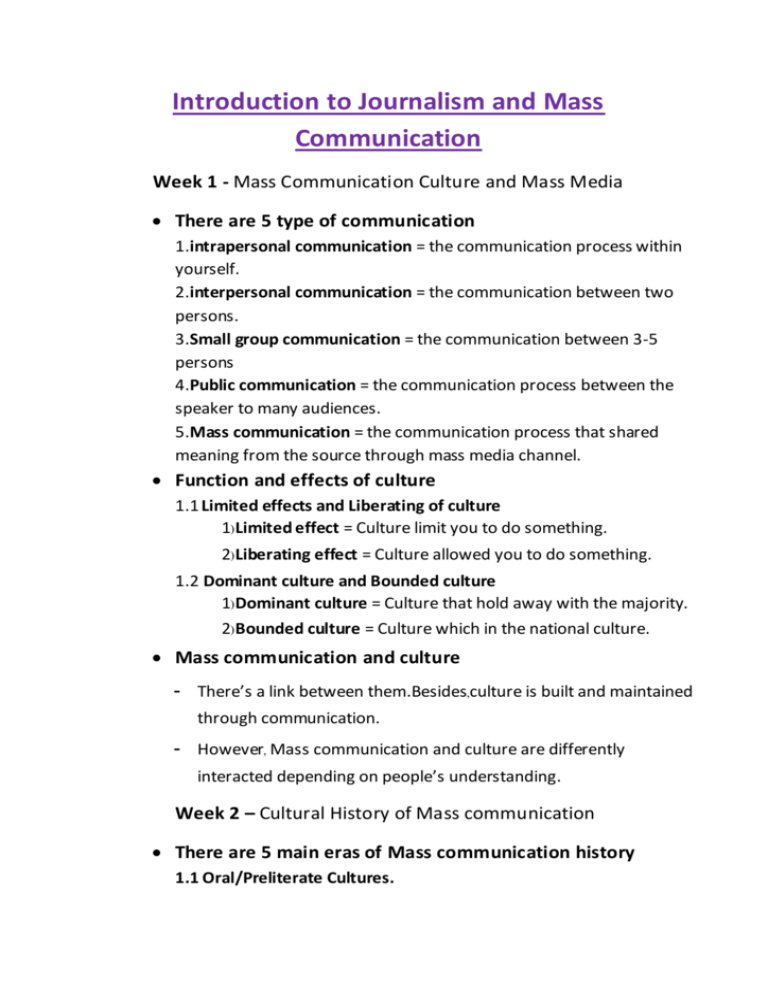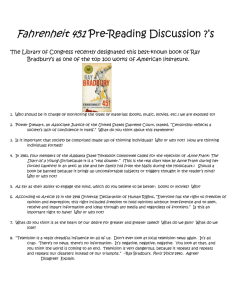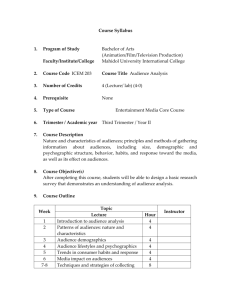Introduction to Journalism and Mass Communication Week 1
advertisement

Introduction to Journalism and Mass Communication Week 1 - Mass Communication Culture and Mass Media There are 5 type of communication 1.intrapersonal communication = the communication process within yourself. 2.interpersonal communication = the communication between two persons. 3.Small group communication = the communication between 3-5 persons 4.Public communication = the communication process between the speaker to many audiences. 5.Mass communication = the communication process that shared meaning from the source through mass media channel. Function and effects of culture 1.1 Limited effects and Liberating of culture 1)Limited effect = Culture limit you to do something. 2)Liberating effect = Culture allowed you to do something. 1.2 Dominant culture and Bounded culture 1)Dominant culture = Culture that hold away with the majority. 2)Bounded culture = Culture which in the national culture. Mass communication and culture - There’s a link between them.Besides,culture is built and maintained through communication. - However, Mass communication and culture are differently interacted depending on people’s understanding. Week 2 – Cultural History of Mass communication There are 5 main eras of Mass communication history 1.1 Oral/Preliterate Cultures. Preliterate Cultures = before human start creating a written language. The storytellers are seen as the meaning maker who blended myth and history together. 1.2 The innovation of writing - - Started by developing alphabets. There’re many type of alphabets such as Hieroglyphics = picture. Cuneiform = symbol. Syllable alphabet = can show the sequences of vowels and consonants in word. In this period,the people also invented the medium for writing form of communication such as papyrus and parchment. Papyrus = Made by Papyrus trees.The process take 12 days Parchment = Made by cow skin.The process take 4 weeks ½ day todry 1.3 Literate Culture Literate Culture = The ability to understand and use written symbols - Writing communication can positively impact on commercial, political,or military expansion - However,in this period,the communication is still limited because it can’t copy 1.4 The Gutenberg Revolution - This period Gudenberg invented The Printing Press call “Gutenberg Press” and the first thing that it made is “Gutenberg Bible”. 1.5The industrial Revolution - In this period,There was a growing number of audiences towards printed information and entertainment. - This is the beginning of the era of mass communication technology. Newspaper,Magazines Motion Picture,and Radio - Helping people to utilize a rapidly expanding,pluralistic,and multitechnic country. Television - In 1945,a very few number of people have a tv set at home. TV became mass medium in 1960 and 90% of US population has TV. Computer Networks - The computer technology brings the world to be the information society,electronic super highway and the information infrastructure. - People search and retrieve information from ‘The world databases’. Development of the Mass Media Industries 1) Innovation Stage - Each of the mass media industries began as an innovator. 2) Penetration Stage - A new media can be successful by generating a new need or increase an existing need depends on competing media. 3) Peak Stage (Maturity) - Peak stage generally happens when the medium achieved maximum penetration. But no new face users. 4) Decline Stage - The medium is characterized by a loss of audience acceptance therefore by a loss of revenues. - Ex. Record tapes. 5) Adaptation Stage - Repositioning is achieved by identifying a new set of needs. Ex. Radio. Week 3 – Use and Function of Mass Communication There are 2 of media analysis towards its function - Macro-analysis - The functions performed by the mass media for the entire society. Micro-analysis - Focusing on the individual receivers of the content which is the audiences. There are 5 main function of media - Function 1 : Surveillance - Give information you need 2 main type of Surveillance 1) Warning or beware 2) Instrumental - - - Function 2 : Interpretation - The mass media do not supply just facts and data.They also provide information on the ultimate meaning and significance of those events. - The individual is exposed to a large number of different points of views,personal channels. Function 3 : Linkage - Mass media are able to join together by interpersonal channel different elements of society that aren’t directly connected. - The public-making ability of media : The media can create totally new social groups by others have similar interest. Function 4 :Transmission of value (Socialization) - Transmission of the social heritage rom one generation to the next – the communication of information,values and social norms such as educational activities. - (as teacher) Mass media can also tranmit values by enforcing social norms. Function 5 : Entertaining - Entertainment – the communication acts focusing on amusement (as entertainers). - The media can make entertainment available to a large number of people at relatively low cost. How people use mass media: - The use -and- gratification model Four category system of how people use mass media 1) Cognition - The act of coming to know something. 2) Diversion - Stimulation,Relaxation,Emotional release. 3) Social Unity - Conversational currency,Parasocial relationship. 4) Withdrawal 6. Theories and Effects of Mass Communications 1) Introduction to Mass Communications Theory Five Eras of media theory - The ear of mass society theory - The emergence of the scientific perspectives - The ear of limited effect theory - The ear of cultural criticism theory - The emergence of a belief in moderate effect the ear of meaning making perspective The Effect Debate - Media content has limited impact on audiences because it is only making people to believe; people know that it is real. - Media content has limited impact audience because it is only play or just entertainment - If media really have effects, they are not the media’s fault. This is because media simply hold a mirror to society and reflect the status, showing us and our world as they already are. Characteristics of mass communication theory - There is no one mass communication theory using to specifically describe or predict the media effects. - Mass communication theories are often borrowed from other fields of science e.g. ‘Attitude Change Theory’ - Mass communication theories are creation - Mass communication are dynamic Hypodermic Needle Theory - Silver bullet theory, Magic bullet theory and one step flow theory - Media are dangerous drug or a killing force that directly and immediately penetrate a person’s system 5. The Frankfurt School - Communization of culture = Media try to create because they try to get the benefits from that culture. - There are a lot of new cultures but low quality. - Mass media is a part of mass culture - Mass media, Media culture, Mass culture The emergence of the scientific perspectives - It is was not enough to merely speculate about the influence of media on society - It was not enough to assume that political propaganda is powerful - The conceptual thinking and theories were needed to prove the existence of such effect The ear of the limited effect theory Two-Step-Flow Theory - Using the us election in 1940 to do the research ‘Why people vote for the president’ - The result found that media almost do not impact on audience’s attitude but opinion leaders. - Limited effect theory - E.g. word of mouth 8. Gatekeeper Theory - Mass Media are seen as the person who can select, create news before transmitting to the audience. - The research is from the activity of local news company - E.g. Editor, news reporter. 9. Attitude Change Theory Dissonance - When confronted by new or conflicting information people experience a king of mental discomfort. - People then try to work reducing the discomfort. Selective Processes - People try to expose themselves and attend to the message linked with their experience - People like to keep or memorize the message being consistent with their preexisting attitudes Reinforcement Theory - We can understand and control the people by the condition that to do something. - ABC Model = Activator, Behavior, Conseguence - Classic conditioning theory Social Cognitive Theory - The idea that the people learn through observation and applying it to mass media, especially television. - The people copy the behavior they see(modeling) 1). Imitation = the direct replication of an observed behavior E.g. a child hit his sister by a stick because of copying from Tom&Jerry Social cognitive theory states that imitation and identification are the products of three processes (1). Observational learning = Can learn new behavior by seeing those behavior performed. (2). Inhibitory effects = to avoid seeing the same situation seen on the screen because the viewer do not want to make that mistake.. (3). Disinhibitory effects = seeing the model are rewarded by doing prohibited or threating behavior such as the glorification of crime and aggressive behavior. Reductionism - Most of the mass communication researchers in the us found limited effect notion and the empirical finding on which they werebased - There fore, mass society noting continued to flourish in Europe Neo-marcism / Neo-Marxist Theory - People are oppressed by those who control the culture, The superstructure (Mass Media) Three main types of news readers: 1). Dominate meaning = Preferred reading 2). Negotiated meaning = Alternative reading 3). Oppositional meaning = the reader interpret opposite from the sender’s expectation News Productive Research Personalized news - Most news stories revolve around people - News will focus on one person or family as a center of its story Dramatized news - Attractive package - Stories must have a hero and a villain, a conflict must be identified and there has to be a showdown Fragmented news - Brief or capsulated stories - Journalist’s obsession with objectivity The emergence of a brief I moderate / the ear of meaning-making perspective 1). Symbolic Interaction - Cultural symbols are learned through interaction and then mediate that interaction. - Symbolic behavior which results in various degrees of shared meaning and values Television can influence viewer in 3 main aspects: - Blurring = TV will ears the real word of audience’s experience. - Blending = TV will mix the reality with TV Culture - Bending = TV will change the audience world turning into the TV mainstream that can support the television benefit. Stereotype - The application of a standardized image or concept to member of certain group. - Linked with cultivation theory, symbolic interaction of realty. - We understand the stereotype from media.




